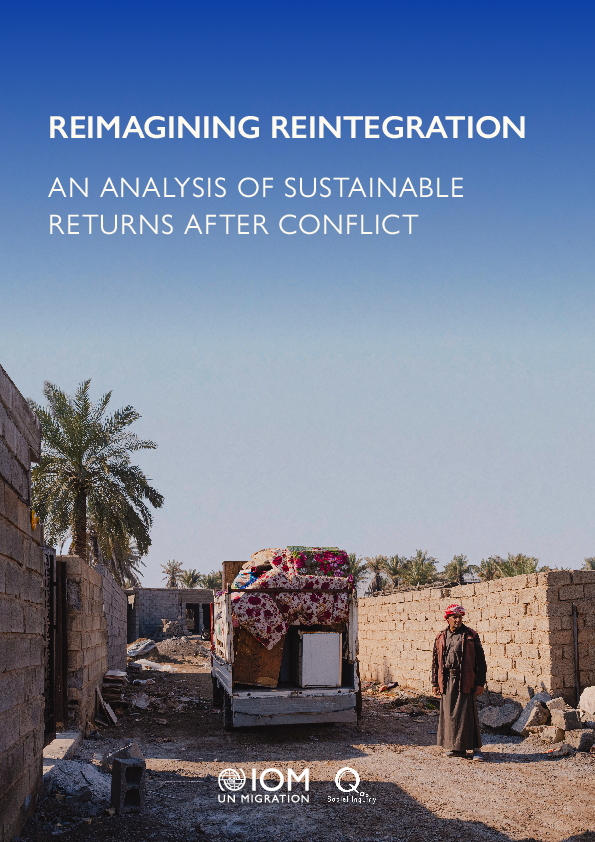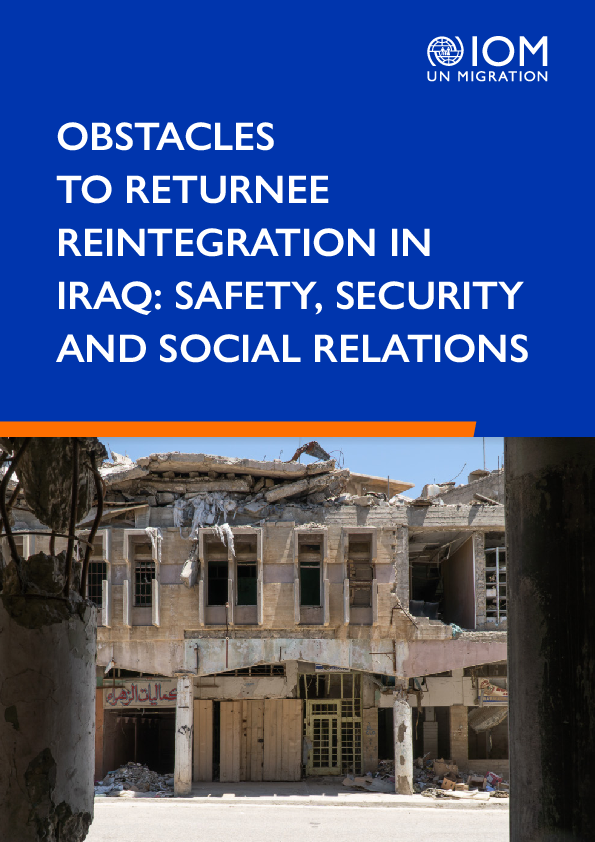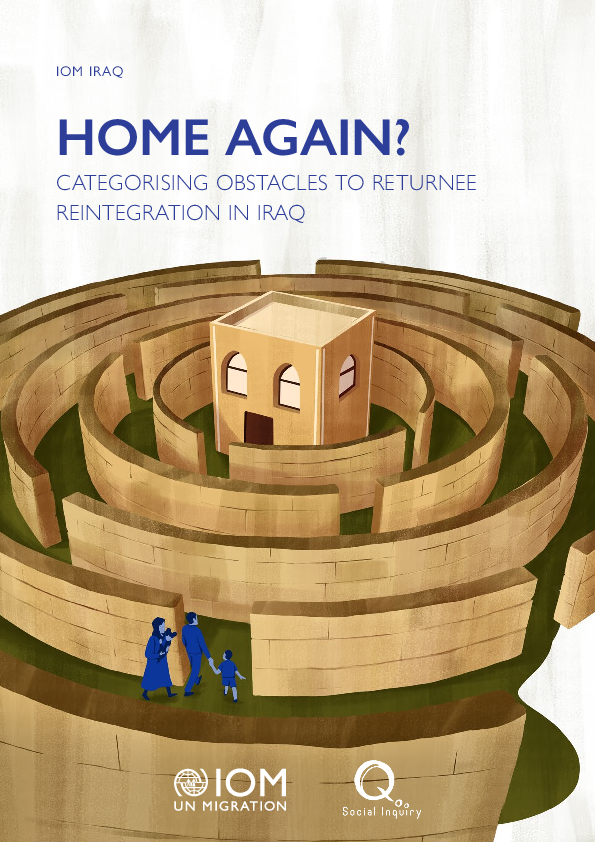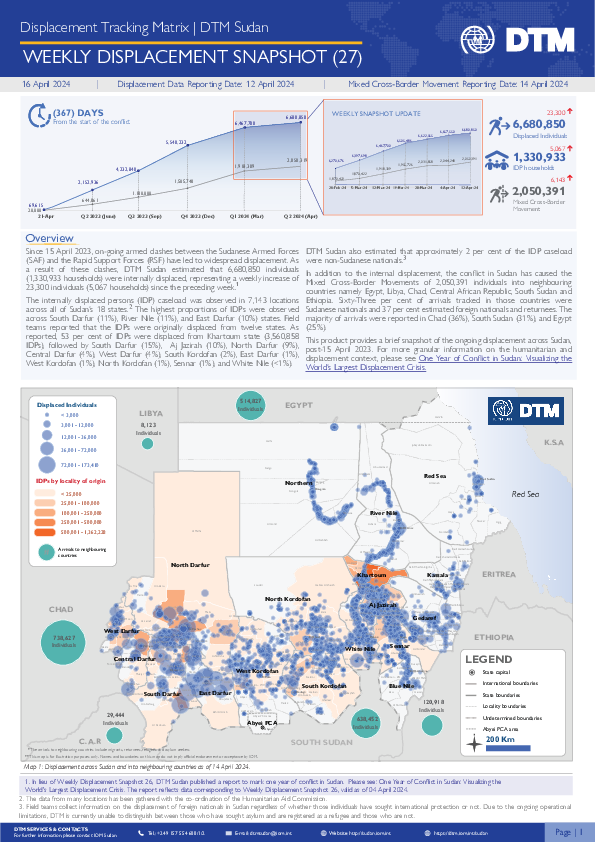-
Countries
-
Data and Analysis
-
Special Focus
-
Crisis Responses
Assessment Report

Contact
DTM Iraq, IraqDTM@iom.int
Language
English
Location
Iraq
Snapshot Date
Mar 22 2022
Activity
- Survey
- Return Intention
- Mobility Tracking
- Baseline Assessment
This report presents an overview of reintegration of returnees across the top 14 districts with the largest number of returnees; altogether, they represent more than 80% of the almost 5 million returnees that IOM’s Displacement Tracking Matrix estimated in March 20221 . This research was designed to obtain a statistically representative sample of the returnee population in each district with at most a 10% margin of error within a 95% confidence interval.

Contact
DTM Iraq, IraqDTM@iom.int
Language
English
Location
Iraq
Snapshot Date
Dec 30 2022
Activity
- Survey
- Return Intention
- Mobility Tracking
- Baseline Assessment
In February 2021, IOM Iraq, the Returns Working Group and Social Inquiry produced a report,Home Again?. The report analyzed the sustainability of reintegration of Iraqi families who had returned to their area of origin after being displaced due to the ISIL conflict. In line with the durable solutions framework developed by the Expert Group on Refugee and IDP Statistics (EGRIS), the report examined the extent to which sustainable reintegration had taken place across five areas.9 The study found that the main challenges to reintegration relate to housing, land and property (HLP); safety, security and social relations; and access to livelihoods and economic security. In 2021, IOM published a report and set of district profiles related to HLP, as well as a report focused on safety, security and social relations. Taken together, this series of reintegration reports – including this report focused on livelihoods and economic security – provides a comprehensive evidence base in support of the advancement towards sustainable reintegration for the 825,372 returnee families across the country.
The objective of this report is to strengthen the evidence-base related to the types of reintegration challenges related to livelihoods and economic security that returnees face across the country. The analysis is structured around the two relevant sub-criteria from the EGRIS framework, as follows: Livelihoods and employment and Economic Security.

Contact
DTM Iraq, IraqDTM@iom.int
Language
English
Location
Iraq
Period Covered
Oct 01 2020
Sep 30 2021
Activity
- Survey
- Return Intention
- Mobility Tracking
- Baseline Assessment
In February 2021, IOM Iraq, the Returns Working Group and Social Inquiry produced a report, Home Again? Categorising Obstacles to Returnee Reintegration in Iraq. It analyzed the sustainability of reintegration for families who had returned to their area of origin after being displaced due to the ISIL conflict.5 In line with the durable solutions framework developed by the Expert Group on Refugee and IDP Statistics (EGRIS), the report examined the extent to which sustainable reintegration had taken place across five areas.6 Persistent issues related to safety, security and social relations were found to represent the most significant barriers to achieving sustainable reintegration amongst returnees in Iraq.
The objective of this report is to inform strategy development and planning in support of the sustainable reintegration of returnees in their area of origin. It provides a snapshot of the key reintegration challenges that returnees face related to safety, security and social relations, and highlights areas where these challenges are most prevalent. Where there is longitudinal data, the report also demonstrates how conditions have changed in the period between October 2020 and September 2021.

Contact
DTM Iraq, IraqDTM@iom.int
Language
English
Location
Iraq
Snapshot Date
Dec 31 2020
Activity
- Survey
- Return Intention
- Mobility Tracking
- Baseline Assessment
This report examines the prevalence of key obstacles for reintegration that returnee households face in Iraq as of mid-2020. These obstacles are grouped into five main criteria, as follows: safety, security & social relations, access to livelihoods & economic security, documentation, property resitution & compensation and adequate standard of living.
As of December 2020, Iraq has witnessed the return of 4.8 million internally displaced persons (IDPs) to their places of origin in the aftermath of the ISIL conflict. 1 Inter-Agency Standing Committee, IASC Framework on Durable Solutions for Internally Displaced Persons. Expert Group on Refugee and IDP Statistics, International Recommendations on IDP Statistics, background document to fifty-first session of the UN Statistical Commission, 3-6 March 2020. This is a significant returnee population and, while the movement home is a first step toward reintegration, it is not necessarily an indication of longer-term sustainability per se.1 The analysis in this report, by IOM Iraq, the Returns Working Group (RWG), and Social Inquiry, builds upon on and complements previous assessments on durable solutions, mainly with regards to obstacles to return as well as progress toward local integration for IDPs. The focus here is specifically on returnees and obstacles to their sustainable reintegration upon return.

Contact
DTM Iraq, IraqDTM@iom.int
Language
English
Location
Iraq
Period Covered
Jul 01 2022
Sep 30 2022
Activity
- Survey
This pilot project aims at assessing progress towards durable solutions to displacement for internally displaced persons (IDPs) and returnees in Ninewa Governorate of Iraq in order to understand where they stand five years after the end of the 2014-2017 crisis and in which aspects they are still struggling compared to the population who never left their location of origin (‘stayees’). In this respect this project contributes to a broader discussion and Action Agenda around measuring progress towards solutions – and determining the end of displacement – which aims at operationalizing the eight criteria of the Framework for Durable Solutions produced by the Inter-Agency Standing Committee (IASC) and informing targeted interventions in key areas of concern. The analysis of this project builds on the information and knowledge gained by the International Organization for Migration (IOM) about the 2014-2017 crisis. IOM Iraq has been tracking and monitoring IDP stock figures as early as December 2013 through the Displacement Tracking Matrix (DTM). The collection of returnee stock figures began in April 2015, although returnee stock figures have been retroactively reported since October 2014. IOM Iraq also uses the Displacement Index and Return Index as tools to monitor the living conditions of the IDP and returnee populations at the location level across key sectors, such as livelihoods, housing, services, safety, social cohesion and inclusiveness.

Contact
DTM Iraq, IraqDTM@iom.int
Language
English
Location
Iraq
Period Covered
Jun 01 2023
Jun 30 2023
Activity
- Survey
This report on Salah al Din Governorate is an extension of the original pilot project in Ninewa aimed at assessing progress towards durable solutions40 to displacement for internally displaced persons (IDPs) and returnees in the governorates with the largest shares of displaced populations in Iraq. The goal is to understand where IDPs and returnees stand five years after the end of the 2014–2017 crisis and in which aspects they are still struggling compared to the population who never left their location of origin (that is, stayees). In this respect, this project contributes to a broader discussion and Action Agenda around measuring progress towards solutions – and determining the end of displacement – which aims at operationalizing the eight criteria of the Framework for Durable Solutions produced by the Inter Agency Standing Committee (IASC) and informing targeted interventions in key areas of concern.

Contact
DTMUkraine@iom.int
Language
English
Location
Ukraine
Period Covered
Mar 01 2024
Mar 31 2024
Activity
- Baseline Assessment
Базова територіальна оцінка зареєстрованих ВПО надає деталізовані дані щодо чисельності та географічного розподілу офіційно зареєстрованих внутрішньо переміщених осіб (ВПО). У звіті оцінено присутність зареєстрованих ВПО на рівні громад із відображенням на мапі зафіксованих змін порівняно з попереднім раундом.
Дані, зібрані для раунду 34 Базової територіальної оцінки, відображають актуальну статистику з місцевого адміністративного реєстру ВПО станом на 31 березня 2024 року, згідно з якою в Україні налічується 3 387 291 зареєстрована ВПО. Дані щодо кількості зареєстрованих ВПО було зібрано для 1 098 громад (83% усіх оцінених громад на підконтрольних українському уряду територіях) у 108 районах 23 областей. Дані з розподілом за віком, статтю та статусом інвалідності було надано для приблизно 83% оцінених адміністративно- територіальних одиниць.

Contact
dtmmozambique@iom.int
Language
English
Location
Mozambique
Period Covered
Apr 11 2024
Apr 16 2024
Activity
- Survey
- Return Intention
IOM’s Displacement Tracking Matrix in collaboration with SDPI conducted a Movement Intention Survey to 783 households hosting 3,136 individuals displaced from Chiure and Macomia districts in Cabo Delgado. Conflict and/or “fear of attacks” due to Non-State Armed Groups (NSAGs) in Cabo Delgado was the main trigger of displacement. At least 70% were displaced from Chiure Velho. 26% from Mazeze and 2% were from Ocua posto. Other postos of origin includes Chiure sede, Katapula, Quiterajo and Mucojo.
The objective of the assessment was to better understand the conditions of the IDP households in the current place of displacement and their short-term intentions. An on-going household verification exercise confirmed the presence of 1,965 households hosting 8,600 individuals in Chiure Posto. Females constitutes 55% of the IDPs whilst 45% are males. Children make up 58% of those remaining displaced within the district.

Contact
DTMUkraine@iom.int
Language
English
Location
Ukraine
Period Covered
Nov 27 2023
Dec 27 2023
Activity
- Survey
Профілі областей ґрунтуються на даних раунду 15 Опитування загального населення МОМ, з акцентом на демографічних показниках і переміщенні населення, довгострокових рішеннях, достатності житла, базових потребах, зайнятості та доходах, а також соціальній згуртованості. Ці дані, згруповані за групами населення на обласному рівні, покликані сприяти прийняттю обґрунтованих рішень щодо стратегічних, технічних і програмних аспектів гуманітарного реагування та відновлення в Україні на основі фактичних даних.

Contact
DTM Sudan; dtmsudan@iom.int
Language
English
Location
Sudan
Period Covered
Apr 05 2024
Apr 12 2024
Activity
- Mobility Tracking
- Baseline Assessment
This report reflects data corresponding to Weekly Displacement Snapshot 27 dataset, valid as of 12 April 2024. The dataset is available here.
Overview
On 15 April 2023, armed clashes erupted between the Sudanese Armed Forces (SAF) and the Rapid Support Forces (RSF) in multiple cities across Sudan. Clashes initially took place in cities across Northern and Khartoum states, later spreading across the Darfur and Kordofan regions.
Highlights
- DTM Sudan estimates that 6,680,850 individuals (1,330,933 households) were recently internally displaced.
- The IDP caseload was observed in 7,143 locations across all of Sudan’s 18 states.
- The highest proportions of IDPs were observed across South Darfur (11%), River Nile (11%), and East Darfur (10%).
- Field teams reported that the IDPs observed were originally displaced from twelve states. The majority (3,560,858 IDPs, 54%) were reportedly displaced from Khartoum state; followed by South Darfur (15%), Aj Jazirah (10%), North Darfur (9%), Central Darfur (4%), West Darfur (4%), South Kordofan (2%), East Darfur (1%), West Kordofan (1%), North Kordofan (1%), Sennar (1%) and White Nile (<1%).
- IOM-DTM also reported that an estimated 2,050,391 mixed cross-border movements were made into neighbouring countries.
- This product provides brief insights into those displaced in Sudan post-15 April 2023. For more granular information on the IDP caseload and the displacement context, please see IOM-DTM's One Year of Conflict in Sudan: Visualizing the World's Largest Displacement Crisis.
Note: In lieu of Weekly Displacement Snapshot 26, DTM Sudan published a report to to mark one year of conflict in Sudan. Please see: One Year of Conflict in Sudan: Visualizing the World's Largest Displacement Crisis. The report reflects data corresponding to Weekly Displacement Snapshot 26 dataset, valid as of 04 April 2024.
Pagination
- Previous page
- Page 36
- Next page
